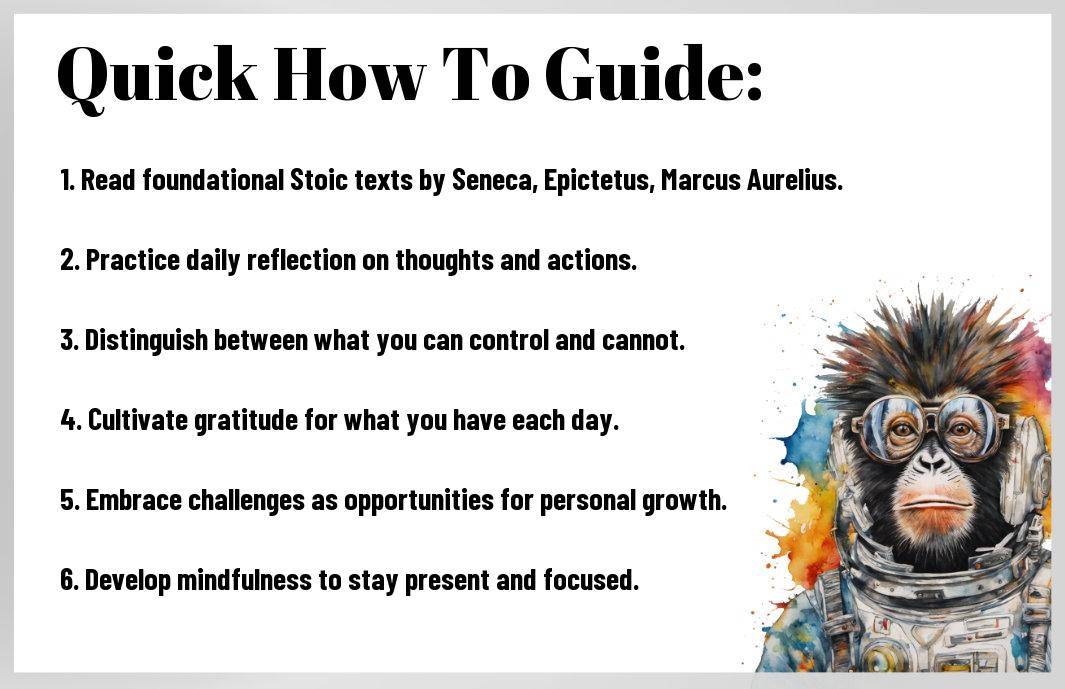Philosophy can often feel distant or complicated, but I’ve discovered that thinking like a Stoic can transform how you approach life’s challenges. In this beginner guide, I’ll share some practical steps that can help you embrace Stoicism in your daily routine. We’ll explore techniques to cultivate resilience, shift your perspective, and find peace amidst chaos. If you’re ready to adopt a mindset that empowers you to navigate life’s ups and downs, then let’s dive in together!
Key Takeaways:
- Understand Control: Focus on what you can control and accept what you cannot.
- Practice Mindfulness: Be present and observant of your thoughts and emotions.
- Seek Wisdom: Continually learn from philosophical texts and teachings to deepen your understanding.
- Embrace Adversity: View challenges as opportunities for growth and resilience.
- Cultivate Virtue: Strive for attributes such as wisdom, courage, justice, and temperance.
- Reflect Regularly: Set aside time for daily self-reflection and examination of your thoughts and actions.
- Practice Gratitude: Acknowledge and appreciate the positive aspects of life, even amidst hardships.


Understanding Stoicism
What is Stoicism?
Stoicism is an ancient philosophical school that emerged in Athens around the early 3rd century BCE. At its core, it teaches the development of self-control and fortitude as a means to overcome destructive emotions. I find it fascinating that the Stoics believed that virtue, defined as the highest good, is based on knowledge and that the wise live in harmony with the Divine Reason that governs nature. Rather than focusing on external circumstances, Stoicism encourages us to concentrate on our thoughts and reactions, which are within our control.
Key Principles of Stoic Thought
What I really enjoy about Stoicism is its practical approach to life’s challenges. One of the key principles is the dichotomy of control, which teaches us that while we cannot control the events that happen to us, we can control how we respond to them. This mindset shift has helped me deal with stressful situations by focusing only on what I can influence. Another important tenet is the idea of living in accordance with nature, which encourages us to recognize our place in the universe and align our actions with our rational nature.
To embrace these key principles, I often remind myself to practice mindfulness and stay present. By reflecting daily on my thoughts and actions, I can better align myself with Stoic ideals. This practice not only enhances my awareness but also allows me to cultivate resilience, ultimately leading to a more peaceful and fulfilling life. As I research deeper into Stoic teachings, I discover that applying these concepts can transform the way I perceive challenges and opportunities alike.

How to Apply Stoicism in Daily Life
There’s a unique comfort in knowing that I can integrate Stoicism into my daily routine, allowing me to navigate life’s challenges with a clearer mind. By adopting a Stoic mindset, I find that I can approach various situations with a greater sense of calm and control. Whether it’s dealing with work pressures or personal conflicts, applying Stoicism helps me maintain perspective and emotional stability.
Practicing Mindfulness
Assuming that I take a moment each day to engage in mindfulness, I can tune into my thoughts and feelings without judgment. This practice allows me to recognize when I’m overwhelmed and helps me detach from negative emotions. I find that when I observe my internal landscape, I can respond to stressors with a sense of clarity, aligning my actions with my values rather than reacting impulsively.
Cultivating Emotional Resilience
The journey of building emotional resilience through Stoicism has been a rewarding one for me. By embracing the idea that I cannot control external events, but can control my reactions to them, I find myself better equipped to handle life’s ups and downs. This perspective shift encourages me to reframe challenges as opportunities for growth, fostering a sense of inner strength.
Practicing this form of resilience involves constantly assessing my thoughts and emotions. I reflect on my experiences regularly, acknowledging what I can learn from each situation. In doing this, I cultivate a robust emotional foundation that helps me bounce back from adversity, ultimately leading to a more fulfilling and balanced life. The more I engage with these Stoic principles, the stronger and more grounded I feel in my everyday life.
Essential Tips for Stoic Thinking
All of us can benefit from incorporating Stoic principles into our daily lives. If you’re looking to start this journey, here are some imperative tips that can guide your thinking:
- Practice mindfulness to observe your thoughts.
- Reflect on your emotions to understand them better.
- Keep a daily journal to track your progress.
- Read Stoic texts to deepen your understanding.
- Engage in regular self-assessment to cultivate awareness.
Knowing these tips is just the beginning; the real transformation comes from applying them to your life.
Embracing Adversity
Even when faced with challenges, I have learned to view adversity as an opportunity for growth. Stoicism teaches us that obstacles are not inherently negative; they can be valuable lessons that strengthen our character and resilience. By shifting my perspective, I often find that setbacks can catalyze innovation and adaptability in my life.
With practice, I’ve become more adept at embracing discomfort rather than avoiding it. The Stoics believed that hardship can lead to a profound understanding of our inner strength. When I lean into uncomfortable situations, I not only learn more about myself but also develop the resilience necessary to navigate life’s inevitable challenges.
Focusing on What You Can Control
Even when situations seem overwhelming, I remind myself to focus solely on what I can control. Stoic philosophy emphasizes that we should direct our energy toward our thoughts, actions, and responses—rather than expend effort on things beyond our influence. This shift in focus allows me to maintain my peace of mind, regardless of external circumstances.
For instance, if I face a challenging situation at work, instead of stressing over outcomes, I concentrate on how I respond and what I can do to improve my skills. This approach not only reduces anxiety but also empowers me to take proactive steps rather than being a passive observer. By consistently applying this principle, I find that I cultivate a sense of autonomy and fulfillment that makes life’s challenges feel less daunting.
Factors That Influence Stoic Mindset
Once again, venturing into the factors that shape a Stoic mindset can really enhance your practice and understanding. These elements play a significant role in developing a robust, Stoic perspective that can help you navigate life’s challenges with grace. Here are a few factors to consider:
- Personal experiences
- Philosophical readings
- Daily practices and habits
- Emotional awareness
- Supportive community
This journey isn’t a solo endeavor; many influences will intertwine to help you on your path. Understanding these factors and how they contribute to your mindset can empower you to embrace Stoicism more fully.
The Role of Reflection
Little by little, I’ve come to appreciate the role of reflection in cultivating a Stoic mindset. Taking time to ponder my thoughts, actions, and reactions allows me to learn from experiences and refine my understanding of Stoic principles. I encourage you to set aside a few moments each day for self-reflection, whether through journaling, meditation, or simple contemplation. This practice not only helps clarify your values but can also lead to a deeper understanding of your emotional responses.
In my experience with reflection, I’ve noticed that it becomes easier to let go of what’s beyond my control and focus on what I can change. This shift in perspective is at the heart of Stoicism. When you incorporate reflection into your daily routine, you’ll likely discover a sense of peace and purpose that aligns perfectly with Stoic teachings.
Community and Mentorship
Mindset can be heavily influenced by our community and mentors. Finding a supportive network of like-minded individuals who share an interest in Stoicism can greatly enhance your journey. Discussions and shared experiences provide new insights and keep you motivated. If you’re able, seek out a mentor who embodies the Stoic principles you wish to cultivate. Their guidance can be invaluable as you navigate the complexities of life.
This sense of community not only allows for shared learning but also builds accountability. When you connect with others who are also studying Stoicism, you can exchange ideas, challenge each other, and grow together. The wisdom shared in these interactions often brings alive the teachings of Stoic philosophers, making them relatable and applicable in today’s world. By fostering connections with others, you’ll find an enriched understanding and appreciation for this profound philosophy.
Daily Stoic Practices
Morning and Evening Routines
Your day-to-day routine can play a significant role in how you embrace Stoic principles. I find that having a structured morning routine helps me set a positive tone for the day ahead. Begin by waking up a little earlier to enjoy some quiet time. This could be a moment of reflection or meditation, where you acknowledge the challenges that may come your way and prepare yourself to respond with resilience. Creating a list of intentions or goals for the day can also be a good practice, allowing you to focus on what truly matters and to align your actions with your values.
In the evening, I like to reflect on the events of the day during my wind-down routine. This is a moment to evaluate my actions, consider what went well, and identify areas for improvement. By doing this, I embrace the Stoic idea of continuous learning, ensuring that with each day, I grow a little wiser and more self-aware. This practice of reflection can pave the way for a more serene evening and can lead to a more fulfilling and purposeful next day.
Journaling for Clarity
Some days, I find that my thoughts can become quite tangled, which is where journaling comes in handy. I use my journal as a space to express my thoughts, clear my mind, and probe into what I am experiencing emotionally and intellectually. Writing allows me to process my feelings and thoughts without judgment, giving me the clarity needed to handle challenges more effectively. I often start my journal entries by reflecting on the Stoic principles I want to apply that day, reminding myself to focus on what is within my control and to accept what is not.
Practices like journaling are wonderful for grounding oneself in the present moment. By putting pen to paper, I can identify my emotions, confront my fears, and even celebrate my successes. This act creates a dialogue between myself and my thoughts, fostering a deeper understanding of my motivations and reactions. In time, I’ve found that journaling serves not only as a therapeutic outlet but also as a guide as I navigate the complexities of life, ultimately helping me to stay aligned with Stoic wisdom. Through these practices, I cultivate a mindset that helps me respond rather than react, fostering inner peace amidst the challenges of life.
Common Misconceptions About Stoicism
Despite its growing popularity, I’ve often noticed that many people hold onto misconceptions about Stoicism. This ancient philosophy is frequently misunderstood and misrepresented in today’s fast-paced world. One of the most surprising things I encounter is that Stoicism is perceived as a rigid, emotionless way of life, which could not be further from the truth. For anyone looking to explore Stoic principles, it’s necessary to first dispel these myths and embrace the philosophy’s true essence.
Stoicism is Not Indifference
Some people mistakenly believe that Stoicism promotes indifference to all emotions, as if Stoics walk through life unmoved by the world around them. In truth, Stoicism teaches us to manage our emotions wisely rather than suppressing them. I think this is a vital distinction. Stoics advocate for the acceptance and examination of emotions—they recognize that feeling anger, sadness, or joy is part of the human experience, but they emphasize the importance of not letting those emotions dictate our actions.
The Balance of Emotion and Reason
If you’re curious about how emotion and reason fit together in Stoicism, you’ll find that it’s all about harmony. Stoics believe that while emotions are natural, it’s our rational mind that should steer how we respond to those feelings. In my own experience, embracing this balance has helped me face life’s challenges with greater clarity and composure, allowing me to respond thoughtfully rather than react impulsively. It’s about acknowledging what you feel, but then taking a step back to consider the best way to move forward.
Indifference to emotions is not what Stoicism promotes; rather, it encourages us to cultivate emotional resilience alongside rational thought. This balance means I can celebrate joyful moments and feel compassion for others without losing sight of my values and objectives. By understanding that emotions come and go, but my reasoning can guide me through them, I find a more fulfilling approach to everyday life. Embracing this principle can be incredibly liberating and can help you navigate even the toughest situations with grace.
Final Words
Hence, embracing Stoicism has been a transformative journey for me, one that I hope you find equally enriching. By integrating these principles into my daily life, I’ve learned to focus on what I can control, let go of unnecessary worries, and cultivate a mindset of resilience. I encourage you to explore these Stoic practices and discover how they can empower you to navigate life’s challenges with grace and wisdom. If you’re just starting out, you might find it helpful to read more details in this How to Learn Stoicism: A Quick Start Guide.
As you commence on this Stoic path, keep in mind that the journey is as important as the destination. Each day presents an opportunity to practice the tenets of Stoicism, layering your understanding and application of these principles in real-world situations. Let’s take this journey together, challenging ourselves to grow, reflect, and ultimately live a more fulfilling life grounded in Stoic thought.
FAQ
Q: What is Stoicism and why should I consider it?
A: Stoicism is a philosophy that emphasizes rationality, self-control, and the acceptance of things beyond our control. It teaches individuals how to maintain a balanced mindset in the face of life’s challenges. By adopting Stoic principles, you may find greater resilience, improved emotional well-being, and a more profound sense of purpose in your daily life.
Q: How can I start incorporating Stoic practices into my daily routine?
A: To start practicing Stoicism, consider integrating daily reflections into your routine. Spend a few minutes each morning or evening contemplating your thoughts, actions, and responses to events. Journaling can be an effective method to capture these reflections. Additionally, practicing mindfulness and focusing on what you can control in any given situation may help embody Stoic principles.
Q: What are some key Stoic principles to focus on as a beginner?
A: Some important Stoic principles include focusing on what you can control and accepting what you cannot, recognizing the impermanence of life, and understanding that external events do not define your happiness. By cultivating an attitude of gratitude and considering the long-term consequences of your actions, you can embody these foundational tenets.
Q: Are there any specific texts or resources that can help me learn more about Stoicism?
A: Yes, some classic texts include “Meditations” by Marcus Aurelius, “Letters from a Stoic” by Seneca, and “Enchiridion” by Epictetus. In addition, there are modern resources such as podcasts, blogs, and online courses dedicated to Stoicism that cater to beginners. Consider exploring these materials for a comprehensive introduction to Stoic philosophy.
Q: How can I deal with negative emotions using Stoicism?
A: Stoicism teaches that negative emotions often arise from our judgments about external events. To manage these emotions, practice reflecting on situations that evoke strong feelings, examining your thoughts about them. Shift your focus to understanding what you can control, and try to develop a rational perspective. Engaging in practices such as cognitive reframing and mindfulness can also help in processing and regulating emotions.
Q: Is Stoicism relevant to modern life, and how can it help with current challenges?
A: Stoicism remains highly relevant today, especially as we face societal pressures, uncertainties, and various challenges. The philosophy provides tools for resilience, enabling individuals to approach difficulties with composure and clarity. By applying Stoic practices such as identifying what truly matters and maintaining a sense of purpose, you can navigate modern life more effectively and cultivate a positive mindset.
Q: Can I combine Stoicism with other philosophies or beliefs?
A: Absolutely! Stoicism is not a rigid doctrine but rather a framework that can coexist with various belief systems. Many find it helpful to integrate Stoic principles with elements from other philosophies, religions, or personal beliefs. The key is to adopt what resonates with you and enhances your understanding of life while fostering a mindset focused on growth, resilience, and well-being.



